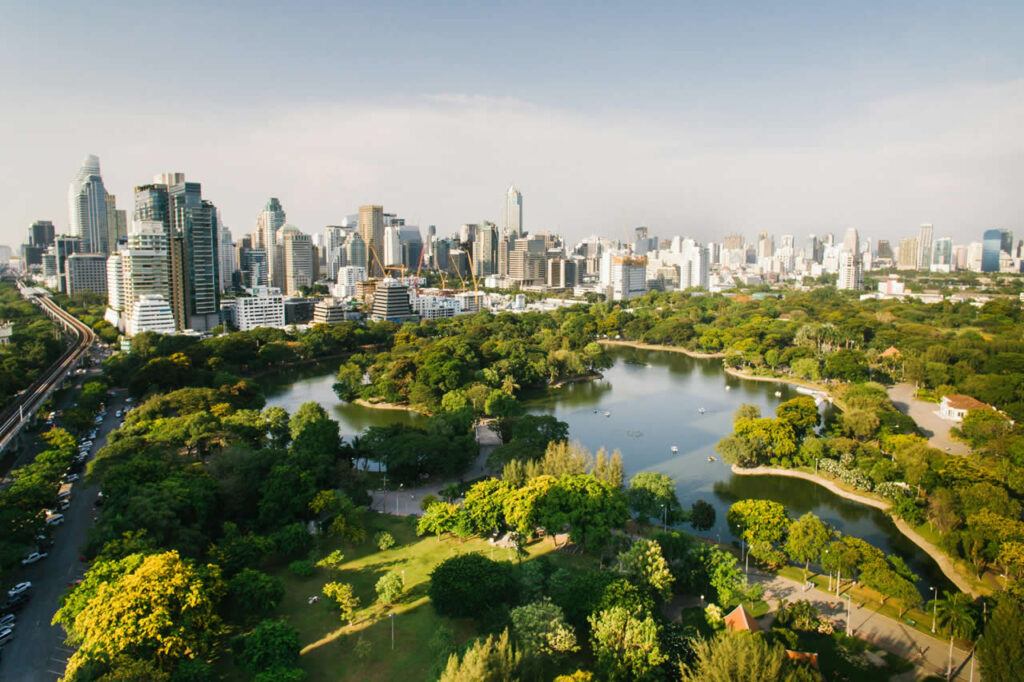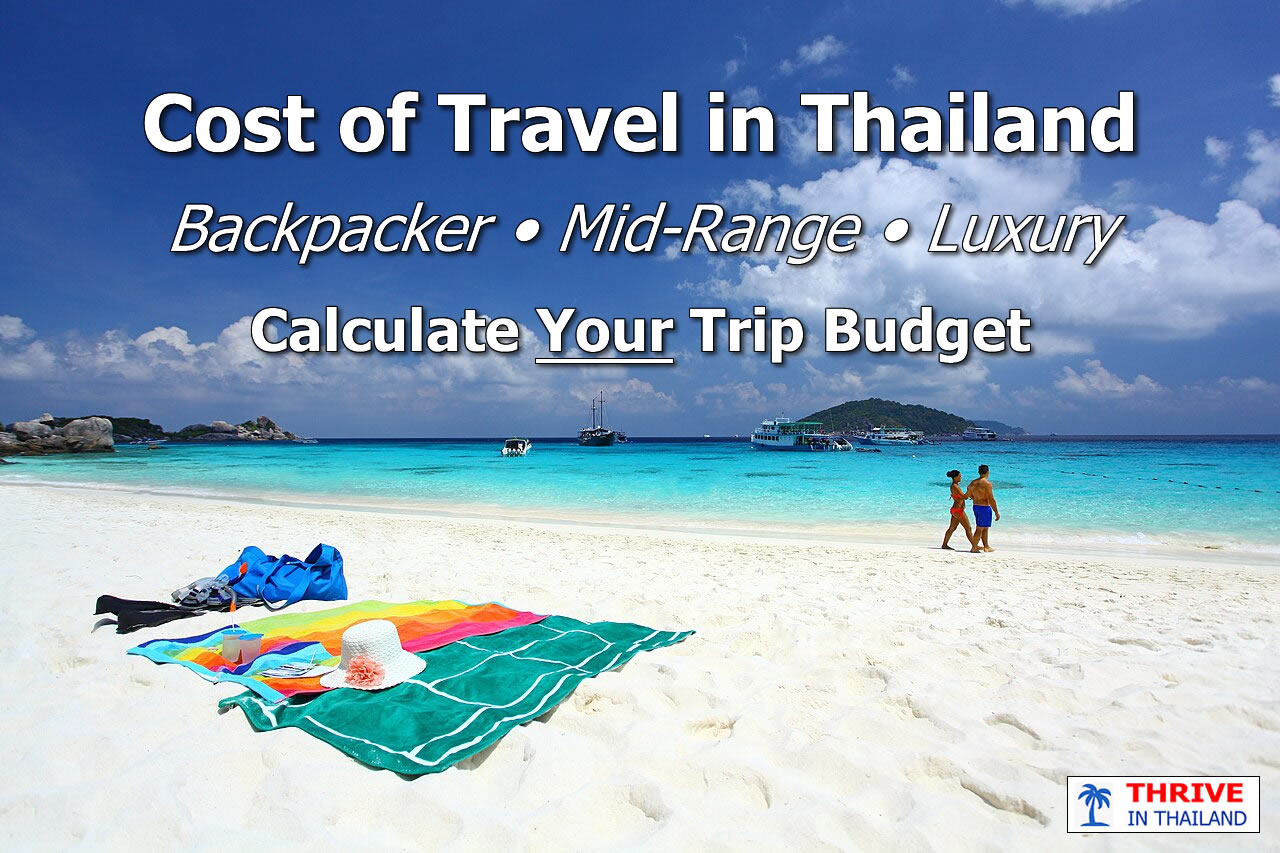
Thailand can still offer excellent value in 2025–2026 — as long as you plan with today’s prices and a realistic daily budget in mind. This guide shows you exactly what to expect: from backpacker basics to boutique comfort, how costs change between Bangkok, Chiang Mai, and the islands, and the little things that quietly nudge budgets up (like season, transport, and activities). All prices are shown in THB and USD so you can decide quickly what works for you.
✈️ New here? Start with the Thailand Tourist Visa Requirements guide to make sure you’re eligible to enter before you plan your budget.
Looking for personalized numbers? Use the Thailand Travel Budget Calculator below. Just enter your nights per destination, pick your travel style, and add extras like activities or alcohol. You’ll get a clear budget breakdown — including a small buffer for real-world surprises. Whether you’re keeping things cheap or splurging a bit, you’ll know your costs before you land.
Plan your trip in THB + USD based on live price assumptions for destinations, seasons, and travel style.
Daily Budget Snapshot (THB + USD)
USD assumes ~36 THB = $1 (adjust in calculator)
| Budget Tier | THB / day | USD / day | What You Get |
|---|---|---|---|
| Backpacker | 1,200–1,800 | ≈$33–$50 | Dorm or budget room, street food, buses/trains, a few paid activities. |
| Mid-range | 2,500–3,500 | ≈$70–$97 | 3★–4★ hotels, cafés & restaurants, occasional flights, regular tours. |
| Luxury | 5,000–9,000+ | ≈$139–$250+ | Resorts, fine dining, private drivers/transfers, spa days, premium tours. |
What Drives the Cost of Travel in Thailand?
Your daily spend isn’t just about whether you’re a “backpacker” or “luxury traveler.” In Thailand, seven main factors influence your real cost per day:

1. Accommodation
Hotels and guesthouses are usually the biggest line item. Prices rise on islands and during peak season, while cities like Chiang Mai or Isaan stay cheaper year-round.
2. Food & Drinks
Thailand is one of the few countries where you can eat for 50 THB or 500 THB on the same street. Street food and Thai shophouses = lowest cost. Western cafés, imported alcohol, and beach bars = instant budget jump.
3. Local Transport
Bangkok has cheap mass transit. Islands don’t. Scooter rentals are affordable, taxis and Grab can add up. Walking-friendly towns (Chiang Mai, Ayutthaya) help keep budgets low.
4. Intercity Travel
Trains and buses are cheap. Domestic flights save time but add cost (especially with luggage). How many destinations you visit matters more than how long you stay.
5. Activities & Tours
Temples and markets are free or low-cost. Island-hopping, diving, cooking classes, national parks, and ethical elephant sanctuaries raise the daily average.
6. Season
Peak season (Dec–Mar, especially on islands) can increase hotel rates by 20–40%. Shoulder season is the sweet spot for both weather and price.
7. Travel Style Extras
Alcohol, spa days, beach clubs, sunset cruises, coworking passes, private drivers — none are “essential,” but they stack up fast.
Typical 2025–2026 Price Ranges (Quick Reference)
These are common prices you’ll see across Thailand. Use them as a baseline — the calculator will fine-tune costs based on destination, season, and travel style.
Food & Drink
(Typical prices in THB – per item)
| Item | Typical Price |
|---|---|
| Street food meal (pad thai, khao man gai, etc.) | 50–80 THB |
| Local restaurant dish | 90–180 THB |
| Café latte / cappuccino | 60–120 THB |
| Fruit shake / smoothie | 40–70 THB |
| Large beer (store) | 60–80 THB |
| Large beer (bar) | 120–180 THB |
| Cocktail (tourist bar) | 180–300 THB |
Accommodation (per night)
| Type | Price Range |
|---|---|
| Hostel dorm bed | 250–450 THB |
| Budget double room | 600–1,000 THB |
| Mid-range hotel (3★–4★) | 1,200–2,200 THB |
| Boutique hotel | 2,500–4,000 THB |
| Resort / beachfront | 4,500–9,000+ THB |
Local Transport
| Item | Price |
|---|---|
| BTS/MRT ride (Bangkok) | 20–55 THB |
| Songthaew (shared pickup truck) | 10–40 THB |
| Taxi / Grab short trip | 60–150 THB |
| Scooter rental (per day) | 200–300 THB (+ fuel) |
| Airport → city taxi (Bangkok) | 250–400 THB |
Intercity & Island Transport
| Item | Price |
|---|---|
| Bus/minivan (avg route) | ~450 THB |
| Train (2nd class fan/AC) | ~700 THB |
| Domestic flight (with bag) | 1,200–2,200 THB |
| Ferry (main routes) | 250–500 THB |
Activities & Extras
| Item | Price |
|---|---|
| Thai massage (1 hour) | 250–400 THB |
| Cooking class | 1,000–1,500 THB |
| National park entry (foreigner rate) | 200–400 THB |
| Snorkeling / island tour | 800–1,800 THB |
| Diving (2-tank day) | 2,500–3,800 THB |
| SIM/eSIM (15–30 days) | 250–400 THB |
Price by Destination (Quick Comparison)
How much pricier or cheaper each place is versus the national average. Use this to split your nights smartly.
| Destination | Cost vs Avg | Notes |
|---|---|---|
| Chiang Mai | ~10% cheaper | Walkable, lots of mid-range value; cafés and massages great value. |
| Bangkok | ~10% higher | Big-city pricing; transit is cheap, accommodation varies by area/season. |
| Phuket | ~25% higher | Island premium, especially Dec–Mar and beach zones. |
| Koh Samui | ~20% higher | Resort-heavy; shoulder season offers better value. |
| Krabi / Ao Nang | ~15% higher | Tour/tour-boat costs nudge the daily average up. |
| Koh Phangan | ~15% higher | Prices spike around party dates; calm weeks are better value. |
| Koh Tao | ~15% higher | Diving adds to budgets; simple rooms still available. |
| Pattaya | ~5% higher | Wide range of pricing; good mid-range deals off-beach. |
| Hua Hin | ~average | Steady prices year-round; good for balanced budgets. |
| Isaan (major cities) | ~20% cheaper | Great food value; fewer tourist mark-ups. |
| Other towns & cities | ~15% cheaper | Less tourist-oriented; offers strong value on food and stays. |
| Other islands | ~20% higher | Logistics + seasonality raise costs; plan ferries carefully. |
What $30 / $60 / $150 a Day Looks Like (Realistic Examples)
Per person, typical prices; excludes flights to Thailand. Use as a feel guide—your calculator will fine-tune by destination and season.

$30/day (~1,100–1,200 THB) – Backpacker
- Stay: Dorm bed or very basic guesthouse
- Food: Street food + market snacks (2–3 meals)
- Transport: Walk, public buses/train; occasional songthaew
- Activities: Free sights; one paid activity every few days
- Example day:
- Breakfast market set (40 THB) • temple visit (free)
- Pad krapao at shophouse (70 THB) • local bus (20 THB)
- Street-stall dinner (60 THB) • dorm (350 THB) • extras (100–200 THB)
$60/day (~2,100–2,200 THB) – Mid-range
- Stay: Solid guesthouse or 3★ hotel (A/C, private bath)
- Food: Mix of Thai eateries + 1 café/coffee
- Transport: BTS/MRT, Grab/taxis for a few hops; scooter in smaller towns
- Activities: Regular paid activities (massages, tours)
- Example day:
- Coffee (90 THB) • museum/park (100 THB)
- Thai lunch (120 THB) • Grab across town (120 THB)
- Massage (300 THB) • dinner at casual restaurant (180 THB)
- Hotel (1,400–1,700 THB)
$150/day (~5,400–5,600 THB) – Boutique/Luxury
- Stay: Boutique hotel or resort (good location, pool)
- Food: Quality cafés + nice dinner; occasional wine/cocktails
- Transport: Private transfers or frequent Grab; short domestic flights
- Activities: Premium tours/spa; island days with boat trips
- Example day:
- Hotel breakfast (incl.) • private transfer (500–800 THB)
- Café stop (150 THB) • premium tour/spa (1,500–2,500 THB)
- Dinner at upscale restaurant (800–1,500 THB)
- Resort (3,500–6,000 THB)
📌 Reality check: Islands and peak season (Dec–Mar) push accommodation up fastest. Chiang Mai and large Isaan cities stretch each budget tier further.
Seasonality & When to Save
Thailand’s prices swing more with season and location than most travelers expect. Here’s the quick, practical view.

🔺 Peak Season (Dec–Mar)
- What happens: Highest hotel rates, busy tours, limited last-minute deals—especially on the islands.
- Where it bites: Phuket/Krabi/Andaman coast and Koh Samui area over Christmas/New Year and Chinese New Year.
- How to save: Book early, stay a bit off-beach, choose shoulder-edge weeks (early Dec, late Mar), and bundle tours locally.
➡️ Shoulder Season (Nov & Apr)
- Why it’s great: Best balance of availability, weather, and value.
- Tactics: Lock in accommodation first, keep activities flexible for weather windows, and consider Chiang Mai or Hua Hin for better mid-range value.
🔻 Low Season (roughly May–Oct, varies by coast)
- Upside: Deep hotel discounts, quieter sights, easier upgrades.
- Watch-outs: More rain on the Andaman side (Phuket/Krabi); some marine parks/boat tours reduce service.
Gulf side (Samui/Phangan/Tao) often has better summer windows (with wetter spells Oct–Dec). - How to save smart: Target weekly rates, pick walkable areas (fewer taxis), and keep one weather buffer day before boat trips.
📌 Rule of thumb: If you’re island-hopping in Dec–Mar, bump the Accommodation line in your calculator first. If you’re traveling May–Sep, try shifting nights toward Chiang Mai/Isaan to stretch your budget.
Thailand Travel Budget Calculator – Build Your Trip Budget
Plan your exact trip cost in THB + USD. Set nights by destination, pick your travel style, choose season and activities—the calculator returns a clear total with a 10% buffer.
- How to use: Enter trip days → split nights by destination → choose style/season → add extras (activities, alcohol, transport).
- What you get: Total trip cost, per-day cost, and a breakdown by Accommodation / Food / Local transport / Activities / Alcohol / Intercity.
- Notes: You can change the FX rate anytime. Island + season multipliers are already built in. Data model updated: Nov 2025.
📌 This calculator covers in-country expenses only (accommodation, food, transport, activities). International flights to Thailand are not included.
Thailand Travel Budget Calculator
Sample Trip Itineraries (With Estimated Cost)
Here’s what typical trips look like when you plug them into the Thailand Travel Budget Calculator. These include accommodation, food, local transport, domestic travel, activities, and a 10% buffer — but exclude international flights to Thailand.
| Trip Type | Destinations & Duration | Travel Style | Estimated Total | Notes |
|---|---|---|---|---|
| 10 Days – Mid-Range | Bangkok (3) → Chiang Mai (4) → Phuket (3) | Mid-range | ~38,000 THB (~$1,050) | Mix of city, culture, and beach. 1 domestic flight + 2 short hops. |
| 14 Days – Backpacker | Bangkok (2) → Ayutthaya (1) → Chiang Mai (4) → Pai (3) → Chiang Mai (2) → Krabi (2) | Backpacker | ~32,000 THB (~$900) | Slow travel, buses/trains, dorms, street food. |
| 7 Days – Luxury Island Escape | Phuket (4) → Koh Yao Noi (3) | Luxury | ~44,000 THB (~$1,220) | Private transfers, spa day, boat tour, premium dining. |
| 21 Days – Balanced Explorer | Bangkok (4) → Chiang Mai (5) → Pai (3) → Krabi (4) → Koh Lanta (5) | Mid-range | ~63,000 THB (~$1,750) | 2 domestic flights, scooter rentals, massages, island tours. |
📌 Adjust nights, swap destinations, or pick a new travel style in the calculator to see how your own trip compares.
Smart Ways to Save (and Mistakes to Avoid)
Thailand is full of great value — if you travel smart. Here’s how to stretch your budget further while avoiding common pitfalls that catch even seasoned travelers.

✅ Do: Travel in Shoulder Season
April and November offer great weather, fewer crowds, and noticeably lower prices — especially on islands and in resorts.
❌ Don’t: Underestimate Island & Transport Costs
It’s not just the ferry — transfers, taxis, and peak-season surcharges add up fast. If you’re hopping multiple islands, budget an extra 20–30% for those days.
✅ Do: Stay Longer in Fewer Places
Slow travel isn’t just relaxing — it’s cheaper. Every destination swap adds bus, ferry, or flight costs. Three stops in two weeks often costs far less than five.
❌ Don’t: Assume “Thailand is Always Cheap”
Western-style habits (lattes, wine, burgers, beach clubs) can quietly double your daily spend. Mix local and Western treats to keep costs balanced and guilt-free.
✅ Do: Use Walkable Cities To Your Advantage
Chiang Mai, Ayutthaya, and Hua Hin are great for avoiding taxis and keeping transport low. Bangkok’s transit is cheap — use BTS/MRT whenever possible.
❌ Don’t: Leave Health Insurance to Luck
One hospital night = an entire week’s travel budget gone. Medical costs rise quickly without insurance. Even a basic travel policy is a smart safety net.
✅ Do: Mix & Match Booking Options
Platforms like Agoda and Booking are great for comparisons, but many guesthouses give discounts via direct message, Line, or walk-in rates.
📌 Want to go deeper on everyday expenses?
Check out my Cost of Living in Thailand Guide for monthly budgets, breakdowns by city, and tips for expats.
Frequently Asked Questions
Still got questions? Here are some quick answers to common traveler concerns – the kind that don’t always make it into guidebooks but matter when you’re budgeting for Thailand.
📌 How much cash should I carry day-to-day in Thailand?
Most places accept mobile payments and cards, but smaller shops and markets still prefer cash. A safe daily amount is 500–1,000 THB in cash, topped up at ATMs or exchange booths as needed.
📌 Do I need to tip in Thailand?
Tipping isn’t mandatory, but it’s appreciated in restaurants (20–50 THB), spas (40–100 THB), and by taxi drivers (rounding up is fine). In higher-end places, 10% is standard.
📌 Are ATMs expensive in Thailand?
Yes — international withdrawal fees are 220–250 THB per transaction. Consider using Wise, Revolut, or local banks with free withdrawal offers (if you have a Thai account).
📌 Can I travel Thailand comfortably without booking anything in advance?
Yes, outside of peak holidays like Christmas and Chinese New Year. In shoulder and low seasons, walk-in rates can even be cheaper.
📌 Is travel insurance required in Thailand?
Not for entry (unless you’re on certain visa types), but highly recommended. Medical expenses and accidents can destroy your budget if uninsured.
💬 Planning a trip to Thailand? Share your budget questions or ideas in the comments — let’s make your trip smoother.

